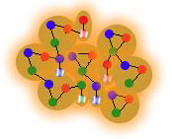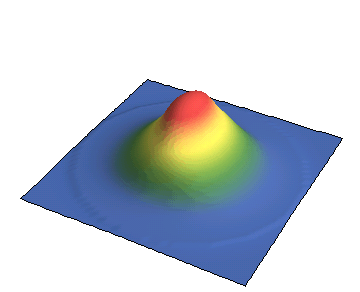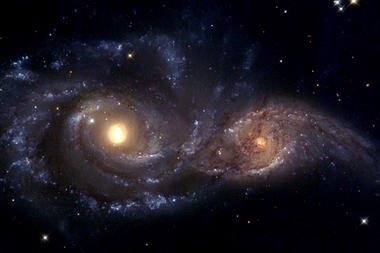Older Research
 Cold Dense Matter
Cold Dense Matter
The determination of the
equation of state for cold, dense nuclear matter e.g. in neuton
stars has been a vexing problem for decades. Since
QCD cannot be accurately solved for densities of interest
in neutron star physics (because of the infamous sign
problem plaguing lattice QCD and the fact that the QCD
coupling becomes sizeable there), a common approach
has been to use phenomenological models. My collaborators
and I have taken a different approach: use microscopic
calculations at low densities (variational, BHF)
and very high densities (pQCD with running coupling and mass)
and match those at some density. The results are encouraging
inasfar as uncertainties are comparatively small and results
are in agreement with present-day neutron star observations.
Below is a list of my contributions to this topic:
-
T. Gorda and P. Romatschke,
The equation of state in two-, three-, and four-color QCD at non-zero temperature and density
PDF, Abstract, (2014).
-
Comments: Using the low-energy plus high-energy matching procedure to obtain non-perturbative information in QCD-like theories. In particular, our results constitute predictions at low temperature, high density, in theories that do not suffer from a sign problem and hence can be simulated within lattice QCD.
Results available
here.
-
A. Kurkela, P. Romatschke, A. Vuorinen and B. Wu,
Looking inside neutron stars: Microscopic calculations confront observations,
PDF, Abstract, (2010).
-
Comments: Applying our matched EoS to rotating neutron stars and
comparing to neutron star observations on mass, frequency and radii.
Results available
here.
-
A. Kurkela, P. Romatschke and A. Vuorinen,
Cold Quark Matter,
PDF, Abstract, Phys.Rev.D81:105021 (2010).
-
Comments: Perturbation theory to O(alpha_s^2) for cold and dense QCD matter
with full strange quark mass effects included (supersedes Freedman/McLerran/Baluni's result).
Constraints on strange quark matter, strangelets, and hybrid quark stars.
Results available
here.
-
Eduardo S. Fraga, Paul Romatschke,
The Role of quark mass in cold and dense perturbative QCD,
PDF, Abstract, Phys.Rev.D71:105014 (2005).
-
Comments: Strange stars, Quark stars, neutron stars?
 Relativistic Viscous Hydrodynamics
Relativistic Viscous Hydrodynamics
Based on experimental data from both the Relativistic Heavy Ion Collider (RHIC) and the Large Hadron Collider (LHC), there is overwhelming evidence that quark-gluon plasmas are behaving almost like ideal fluids. I have been involved in both defining the correct form of the equations of relativistic fluid dynamics as well as numerically solving those in situations that mimic those encountered in relativistic heavy-ion collisions. Work on the subject
of viscous hydrodynamics evolved from
studies in 0+1 dimensions ("Bjorken flow") over 1+1 dimensions
("Transverse flow") to 2+1 dimensions ("Elliptic flow"), and more recently to lumpy initial conditions giving rise to all harmonics (in particular "Triangular Flow"). More recent work focusses on issues 'beyond'-hydrodynamics, for which the gauge/gravity duality has been an important tool.
-
M. Habich, J.L. Nagle and P. Romatschke,
Particle spectra and HBT radii for simulated central nuclear collisions of C+C, Al+Al, Cu+Cu, Au+Au, and Pb+Pb from Sqrt(s)=62.4-2760 GeV,
PDF, Abstract.
-
Comments: We use SONIC (an AdS+hydro+cascade simulation package hybrid) to simulate symmetric central nuclear collisions at RHIC and the LHC. To download the codes and results, visit
this site
-
T. Gorda and P. Romatschke,
Precision studies of vn fluctuations
PDF, Abstract, Phys.Rev. C90 (2014) 5, 054908.
-
P. Kovtun, G.D. Moore and P. Romatschke,
Towards an effective action for relativistic dissipative hydrodynamics
PDF, Abstract, JHEP 1407 (2014) 123.
-
Comments: An effective action for relativistic hydrodynamics with dissipation.
-
M. Habich and P. Romatschke,
Onset of cavitation in the quark-gluon plasma
PDF, Abstract, JHEP 1412 (2014) 054.
-
Comments: If the bulk viscosity coefficient is too large, the quark gluon plasma will undergo bubble formation ('cavitation') to a confined phase. Since this seems experimentally disfavored, we derive an upper bound on the bulk viscosity over entropy density coefficient in high temperature QCD.
-
J.L. Nagle et al.,
Exploiting Intrinsic Triangular Geometry in Relativistic He3+Au Collisions to Disentangle Medium Properties
PDF, Abstract, Phys.Rev.Lett. 113 (2014) 11, 112301.
-
Comments: We proposed that colliding different light nuclei on heavy nuclei, in particular He3 on Au, may help to disentangle initial state and medium properties.
UPDATE: He3+Au triangular flow has been measured by the PHENIX experiment, see here.
-
W. van der Schee, P. Romatschke and S. Pratt,
Fully Dynamical Simulation of Central Nuclear Collisions,
PDF, Abstract, Phys.Rev.Lett. 111 (2013) 22, 222302.
-
Comments: Matching pre-equilibrium dynamics (simulated via AdS/CFT) to viscous hydrodynamics (vh2) to hadron cascade (B3D); first incarnation of 'SONIC'. To download the codes and results, visit
this site
-
P. Romatschke,
Relativistic (Lattice) Boltzmann Equation with Non-Ideal Equation of State
PDF, Abstract, Phys.Rev. D85 (2012) 065012.
-
Comments: Relativistic Fluid Dynamics Algorithm for Non-Ideal Equations
of State.
-
P. Romatschke, M. Mendoza and S. Succi,
A fully relativistic lattice Boltzmann algorithm,
PDF, Abstract, Phys.Rev. C84 (2011) 034903.
-
Comments: A new computational fluid dynamics (CDF) algorithm for
relativistic hydrodynamics. Ideal equations of state only. Download code here
-
P. Kovtun, G.D. Moore and P. Romatschke,
The stickiness of sound: An absolute lower limit on viscosity and the breakdown of second order relativistic hydrodynamics,
PDF, Abstract, Phys.Rev. D84 (2011) 025006.
-
Comments: Effect of thermal noise on hydrodynamic transport coefficients.
-
P. Romatschke,
Relativistic Viscous Fluid Dynamics and Non-Equilibrium Entropy,
PDF, Abstract, Class.Quant.Grav.27:025006 (2010).
-
Comments: Most general form of 2nd order non-conformal fluid dynamic equations (at zero charge
density). Also derived is the form of the non-equilibrium entropy current in the fluid
dynamics regime.
-
P. Romatschke,
New Developments in Relativistic Viscous Hydrodynamics,
PDF, Abstract, Int.J.Mod.Phys.E19:1-53 (2010).
-
Comments: Review of recent progress in relativistic viscous hydrodynamics.
-
M. Luzum and P. Romatschke,
Viscous Hydrodynamic Predictions for Nuclear Collisions at the LHC
PDF, Abstract, Phys.Rev.Lett.103:262302 (2009).
-
Comments: Predictions for lead-lead and proton-proton collisions at the LHC.
Download code and results
here!
-
M. Luzum and P. Romatschke,
Conformal Relativistic Viscous Hydrodynamics: Applications to RHIC
PDF, Abstract, Phys.Rev.C78:034915 (2008)
-
Comments: Results from conformal viscous hydro on Au+Au collisions
at RHIC, for Glauber and CGC initial conditions. Details of Setup.
Dependence on 2nd order coefficients and Cooper-Frye ansatz discussed.
Discussion of early thermalization and viscosity over entropy ratio.
Download Results
here!
Update: we fixed a bug in the calculation for the resonances (see
published erratum: Phys.Rev.C79:039903(E), 2008); revised plots/data
will be made available soon.
-
R. Baier, P. Romatschke, D.T. Son, A.O. Starinets, M.A. Stephanov,
Relativistic viscous hydrodynamics, conformal invariance, and holography,
PDF, Abstract, JHEP 0804:100, (2008).
-
Comments: Fixing the form of second-order relativistic
viscous hydrodynamic equations;
supersedes Israel-Stewart theory
- Paul Romatschke,
Fluid turbulence and eddy viscosity in relativistic heavy-ion collisions,
PDF, Abstract, (2007).
-
Comments: Thoughts about Fluid Turbulence
- Paul Romatschke, Ulrike Romatschke,
How perfect is the RHIC fluid?
PDF, Abstract, Phys. Rev. Lett.99, 172301 (2007).
-
Comments: Viscous Hydrodynamics for Non-central Collisions, Elliptic flow,
Comparison to Data
-
Download Code
here!
-
Paul Romatschke,
Causal Viscous Hydrodynamics for Central Heavy-Ion Collisions II:
Meson Spectra and HBT Radii
PDF, Abstract, Eur.Phys.J.C52:203-209 (2007).
-
Comments: Viscous Hydrodynamics for Central Collisions, Freeze-Out and
Comparison to Data
-
Download Code+Results
here!
-
Rudolf Baier, Paul Romatschke,
Causal Viscous Hydrodynamics for Central Heavy-Ion Collisions,
PDF, Abstract, Eur.Phys.J.C51:677-687 (2007).
-
Comments: Viscous Hydrodynamics for Central Collisions, Transverse flow,
Code tests
-
Rudolf Baier, Paul Romatschke, Urs Achim Wiedemann,
Transverse flow in relativistic viscous hydrodynamics,
PDF, Abstract, Nucl.Phys.A782:313-318 (2007).
-
Comments: How not to Approximate Viscous Hydrodynamic Equations
-
Rudolf Baier, Paul Romatschke, Urs Achim Wiedemann,
Dissipative hydrodynamics and heavy ion collisions,
PDF, Abstract,
Phys.Rev.C73, 064903 (2006).
-
Comments: Viscous Hydrodynamic Equations I, Bjorken flow.
 Nonlinear Gravity
Nonlinear Gravity
-
H. Bantilan and P. Romatschke,
Simulation of Black Hole Collisions in Asymptotically AdS Spacetimes
PDF, Abstract.
-
Comments: We perform the first successful simulations of black hole collisions in asymptotic AdS spacetimes. These studies could help to understand the pre-equilibrium dynamics of heavy-ion collisions via the gauge/gravity duality.
-
Download movies and other results
here!
-
Paul Romatschke and J. Drew Hogg,
Pre-Equilibrium Radial Flow from Central Shock-Wave Collisions in AdS5
PDF, Abstract, JHEP 1304 (2013) 048.
-
Comments: A numerical solution to a toy model of a
high energy particle collision in a strongly coupled gauge theory.
-
Bin Wu and Paul Romatschke,
Shock wave collisions in AdS5: approximate numerical solutions
PDF, Abstract, Int.J.Mod.Phys. C22 (2011) 1317-1342.
-
Comments: A numerical solution to a toy model of a
high energy particle collision in a strongly coupled gauge theory.
-
Daniel Grumiller, Paul Romatschke,
On the collision of two shock waves in AdS5
PDF, Abstract,
JHEP 0808:027 (2008).
-
Comments: A (partial)
solution to a toy model of a high energy particle collision
in a strongly coupled gauge theory.
Non-Abelian Plasma Instabilities
Plasma instabilities in QCD are a very interesting and rich
phenomenon that may perhaps lead to fast equilibration
in the context of heavy-ion collisions. Much progress has been
made in recent years, but a thorough understanding of non-Abelian
plasma instabilities in heavy-ion collisions is still missing.
Below is a list of my contributions to this topic,
-
P. Romatschke,
Momentum broadening in an anisotropic plasma,
PDF, Abstract, Phys. Rev. C75, 014901 (2007).
-
Comments: Jet broadening in an anisotropic QCD plasma: "the ridge"
-
See arxiv source for numerics
-
P. Romatschke and A. Rebhan,
Plasma Instabilities in an Anisotropically Expanding Geometry,
PDF, Abstract, Phys. Rev. Lett.97, 252301 (2006).
-
P. Romatschke and R. Venugopalan,
The Unstable Glasma,
PDF, Abstract, Phys. Rev. D74, 045011 (2006)
-
P. Romatschke and R. Venugopalan,
A Weibel instability in the melting color glass condensate
PDF, Abstract,
Eur. Phys. J. A29:71-75 (2006).
-
P. Romatschke and R. Venugopalan,
Collective Non-Abelian Instabilities in a Melting Color Glass
Condensate,
PDF, Abstract, Phys. Rev. Lett.96, 062302 (2006).
-
Comments: Full 3D simulation of classical chromodynamics in
expanding space
-
Download Code
here!
-
A. Rebhan, P. Romatschke and M. Strickland,
Quark-Gluon-Plasma Instabilities in Discretized Hard-Loop Approximation,
PDF, Abstract, JHEP 0509:041 (2005).
-
A. Rebhan, P. Romatschke and M. Strickland,
Hard-Loop dynamics of Non-Abelian Plasma Instabilities,
PDF, Abstract, Phys. Rev. Lett.94, 102303 (2005).
-
P. Romatschke and M. Strickland,
Progress in Anisotropic Plasma Physics,
PDF, Abstract (2004).
-
P. Romatschke and M. Strickland,
Collisional Energy Loss of a Heavy Quark in an Anisotropic Quark-Gluon Plasma,
PDF, Abstract,
Phys.Rev.D71, 125008 (2005).
-
Numerics setup can be found here! Warning: unmaintained and not commented.
-
P. Romatschke and M. Strickland,
Collective Modes of an Anisotropic Quark-Gluon Plasma II,
PDF, Abstract (2004), Phys. Rev. D70, 116006 (2004).
-
P. Romatschke and M. Strickland,
Energy Loss of a Heavy Fermion in an Anisotropic QED Plasma,
PDF, Abstract, Phys. Rev. D 69, 065005 (2004).
-
Numerics setup can be found here! Warning: unmaintained and not commented.
-
P. Romatschke and M. Strickland,
Collective Modes of an Anisotropic Quark-Gluon Plasma,
PDF, Abstract, Phys. Rev. D 68, 036004 (2003).
Various other projects
-
P. Romatschke and S. Pratt,
Extracting the shear viscosity of a high temperature hadron gas
PDF, Abstract.
-
Comments: We calculate the shear viscosity over entropy density ratio in a hot hadron gas by direct numerical measurements in a hadron cascade code (B3D).
-
P. Arnold, P. Romatschke and W. van der Schee,
Absence of a local rest frame in far from equilibrium quantum matter
PDF, Abstract,
JHEP 1410 (2014) 110.
-
Comments: Explicitly shows that there are situations for out-of-equilibrium quantum matter in which one can not boost into a frame where energy density is not flowing.
-
A. Adare et al.,
Examination whether heavy quarks carry information on the early-time coupling of the quark-gluon plasma,
PDF, Abstract,
Phys.Rev. C90 (2014) 2, 024911.
-
P. Romatschke and D.T. Son,
Spectral sum rules for the quark-gluon plasma,
PDF, Abstract,
Phys.Rev.D80:065021 (2009).
-
Comments: Sum rules for Energy-Momentum Tensor Correlators in SU(N) and N=4 SYM.
C++ code used to check sum rules for N=4 SYM is available
here.
-
M. Laine, O. Philipsen, P. Romatschke, M. Tassler,
Real-time static potential in hot QCD,
PDF, Abstract, JHEP 0703:054 (2007).
-
Comments: Quarkonia
-
Paul Romatschke,
Quasiparticle description of the hot and dense quark gluon plasma.
PDF, Abstract, (2003).
-
Comments: PhD thesis
- Anton Rebhan, Paul Romatschke,
HTL quasiparticle models of deconfined QCD at finite chemical potential,
PDF, Abstract, Phys.Rev.D68:025022 (2003).
-
Comments: The HTL Quasiparticle model
- Download results
here !
- Paul Romatschke,
Cold deconfined matter EOS through an HTL quasiparticle model,
PDF, Abstract, (2002).
-
Comments: My first preprint :-)
- Paul Romatschke,
Thermal corrections to the sunset diagram, unpublished,
ps (2001).
-
Comments: Diploma thesis